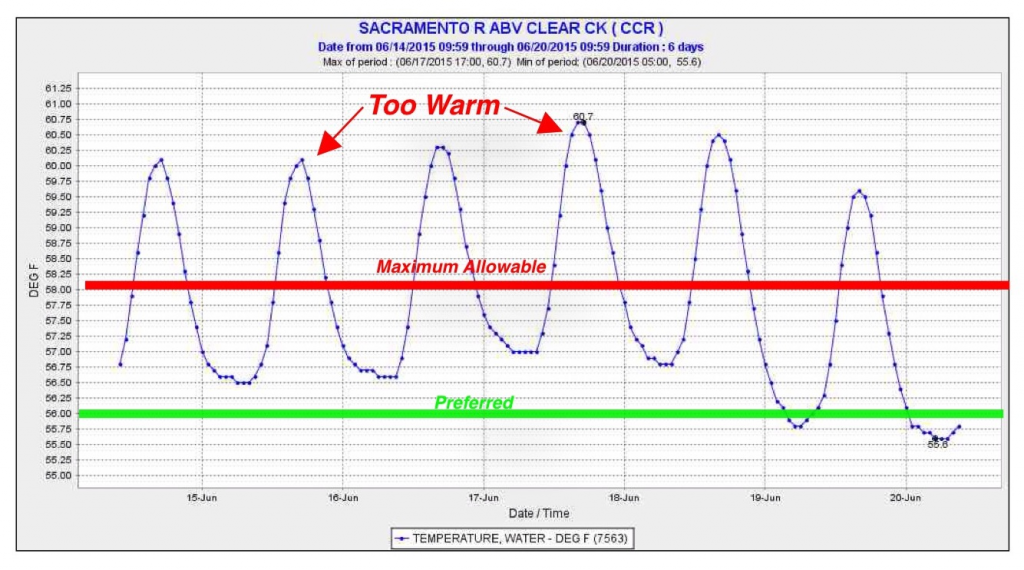By now it is common knowledge that 95% of last year’s endangered Winter Run Chinook salmon production in Sacramento River below Shasta-Keswick Dams was lost due to low flows and high water temperatures in summer. Large losses also occurred to Spring Run and Fall Run salmon. As they did last year, the US Fish and Wildlife Service, National Marine Fisheries Service, US Bureau of Reclamation, California Department of Fish and Wildlife, and California State Water Resources Control Board are managing water releases from Shasta Reservoir to ensure flows and water temperatures are adequate for Spring Run and Winter Run salmon spawning adults and eggs and alevins in gravel beds. This year they all assured us they had adequate water and cold water pool to maintain flow and cool water temperatures to protect the salmon in the upper spawning reach near Redding. They acknowledged there was insufficient water to protect the lower spawning reach below Redding (down to Red Bluff).
Already two months into the irrigation season and after a quarter million acre-feet of water released to water contractors (about 10% of Shasta storage and 25% of the cold water pool), Reclamation has determined they overestimated the available amount of cold water pool and their ability to maintain flow and water temperatures for salmon into the fall. Fearing the worst, storage releases have been reduced, and protective water temperature limits in the Redding spawning reach have been raised to conserve the cold water pool.
We only have to look at the State Board’s own science review of water temperature effects on salmon1 to see if water management in the spawning reach is protecting salmon.
- Mean Weekly Maximum Water Temperature (MWMT) should not exceed 13C (55.4F) – generally referred to as 56°F limit.
- Keswick Dam releases have been slightly higher than 56°F MWMT.
- Sacramento River compliance point above Clear Creek has MWMT of 60°F.
- Clear Creek upstream of mouth has a MWMT greater than 60°F.
- Sacramento River below Clear Creek at Anderson has MWMT OF 62°F.
- Daily maximum water temperature should not exceed 13.5-14.5°C (56-58°F) from fertilization through fry development.
- Keswick releases have reached 56°F.
- Sacramento River at compliance point above Clear Creek has reached 60.7°F.
- Sacramento River below Clear Creek at Anderson has reached 62°F.
- Optimal temperatures for egg incubation is <13°C (55°F).
- Exceeded throughout spawning reach.
- Water temperature when pre-spawning mortality of adult Chinook becomes pronounced in ripe adult salmon – 13-15.5°C (55-60°F)
- Exceeded throughout spawning reach.
Obviously the 56-60°F maximum daily water temperatures in the primary spawning reach above the mouth of Clear Creek at Redding are a concern. The State Board has raised compliance from 56°F to 58°F in attempt to conserve cool water through the summer. They have also reduced allowed Keswick releases from 8000-9000 cfs to 7500 cfs for the summer to save storage and the cold water pool. Reclamation is keeping Keswick releases near 7000 cfs.
Our concern is for pre-spawn ripe adult mortality and egg viability, as well as egg viability and embryo survival in redds. The agencies seem to think maximum daily temperatures near 60°F are ok, when they are not. Destroying this year’s egg production before the cold water pool is exhausted should not be the approach. Maximum temperatures should not exceed 56°F above Clear Creek. A maximum temperature of 58°F should be the absolute limit.
Far more important is the water temperatures in the redds, which tend to occur in shallow pool tailouts that are often warmer than average river temperatures. There must be a margin of protection for this difference. Redd temperatures should also be carefully monitored.

